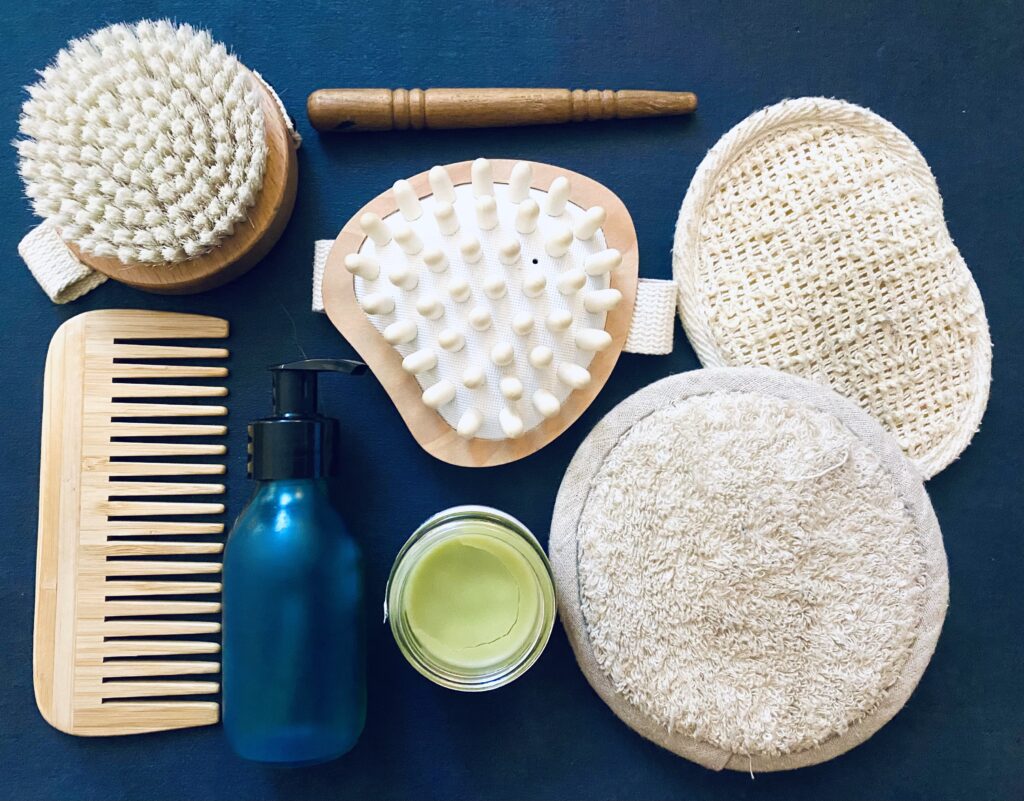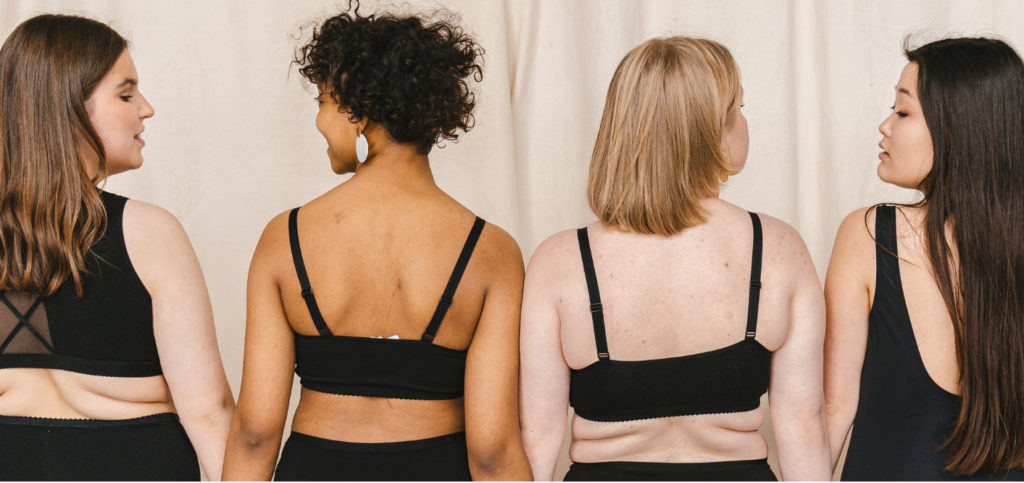

Why Breast Health & Comfort Deserves a Place in Yoga
You probably know that breasts change throughout every menstrual cycle? During the luteal phase, progesterone causes milk glands and ducts to swell in preparation for potential pregnancy, which is why many women experience breast fullness or tenderness before their period begins.
But did you know that breast support comes from structures called Cooper’s ligaments—fibrous bands connecting to your collarbone and chest fascia? Unlike muscles, these ligaments can stretch over time but cannot be strengthened through exercise, making posture and movement awareness particularly important for long-term comfort.
Breast tissue undergoes remarkable transformations throughout a woman’s life, responding to hormonal shifts. Moreover, women’s responses to these shifts are coloured by social and cultural norms wherever we happen to be in the world and affect women’s sense of themselves. Each society’s views and taboos around breasts have changed over the centuries. In many ancient cultures, women’s clothing was often quite revealing, with little to no coverage of the breasts, particularly where women were considered to be sacred or divine. Today, images of breast exposure and breast feeding often provoke very strong reactions.
How Breast Tissue Develops
Breast tissue starts developing during the embryonic stage—and continues evolving through distinct phases that deserve our attention and care.
During childhood, breasts consist mainly of connective tissue with a small network of ducts, remaining relatively unchanged until puberty arrives. Between ages 8-13, estrogen stimulates growth of ductal tissue while progesterone promotes development of lobular tissue. Fat deposition increases, giving breasts their characteristic shape, and Cooper’s ligaments develop their crucial supportive network.
Reproductive Years: Monthly Rhythms
Throughout the reproductive years, breasts are affected to varying degrees by the hormones of the menstrual cycle. Understanding this pattern can help women recognise what’s normal for their bodies:
Follicular Phase (Days 1-14): Early in the cycle, when estrogen begins rising, breast tissue is usually less full. As estrogen increases, blood flow to breast tissue gradually increases and ducts begin to slightly expand.
Luteal Phase (Days 15-28): After ovulation, progesterone levels rise significantly. Milk glands and ducts swell in preparation for potential pregnancy, increased fluid retention occurs in breast tissue, and many women experience the familiar fullness, tenderness, or sensitivity. Some experience lumpiness that resolves after menstruation begins—part of what’s medically called cyclical mastalgia.
This monthly cycle explains why a breast examination might feel different depending on when it’s performed, and why some women find certain yoga poses more or less comfortable at different times of the month.
The Twenties and Thirties
During young adulthood, breasts reach full development with prominent glandular tissue and higher density visible on mammograms. Interestingly, this is also the most common period for fibroadenomas to develop in around 9% of women although they can occur at any age. Fibroadenomas are benign, mobile, rubbery lumps influenced by estrogen that are completely normal but of course can cause concern for women finding this kind of change.
Pregnancy and breast feeding: Dramatic Transformation
Few experiences transform breast tissue as dramatically as pregnancy and breast feeding. Increases in estrogen and progesterone cause significant growth as milk-producing lobules multiply and enlarge. Blood flow increases substantially, and breasts may increase by up to a third in size during breast feeding as alveoli fill with milk and ducts expand to accommodate milk flow.
After breast feeding stops, milk-producing structures gradually involute (shrink), but many women notice permanent changes in breast size, shape, or density. Understanding that these changes are normal parts of the feminine experience can help women approach them with acceptance rather than distress.

Perimenopause: The Time of Unpredictability
Perhaps no phase of breast health is less understood than perimenopause, typically beginning in a woman’s 40s. During this transition, estrogen and progesterone levels become erratic and unpredictable, creating irregular hormone patterns that can cause confusing breast symptoms. Some months may bring more pronounced tenderness or swelling than usual, while other months might have minimal symptoms.
Structural changes also begin during this phase. There’s a gradual decrease in glandular tissue, fibrous tissue starts being replaced by fatty tissue, and breast density typically begins to decrease. Cooper’s ligaments may begin to stretch, initiating some sagging, and women might notice changes in breast size—either increases due to weight gain or decreases due to tissue changes.
Common benign conditions during this phase include cysts (fluid-filled sacs), fibrocystic changes (general lumpiness and tenderness), fat necrosis (damaged fatty tissue), and sclerosing lesions (areas of hardened tissue). Existing fibroadenomas typically begin to shrink as estrogen levels decline.
Breast cysts deserve special mention, as they’re most common during perimenopause. These fluid-filled sacs develop as a result of hormonal fluctuations characteristic of this transitional period, may fluctuate in size during menstrual cycles, and can sometimes become tender or painful.
Menopause and Beyond: New Equilibrium
After menopause, declining estrogen leads to replacement of glandular tissue with fatty tissue. Breasts often become less dense and more fatty, Cooper’s ligaments may stretch further, and size may decrease or increase depending on overall body fat changes. Fibroadenomas continue to decrease in size or calcify, and there’s continued replacement of glandular with fatty tissue.
A Missing Element in Yoga Training
Despite these profound changes affecting millions of women throughout their lives, most yoga training and yoga classes don’t address breast comfort or health specifically. Traditional yoga teacher training programs spend extensive time on anatomy and alignment for nearly every part of the body—detailed instruction on hip alignment, shoulder positioning, spinal curves—yet breasts are rarely mentioned.
This oversight means that women often adapt yoga poses on their own, sometimes experiencing discomfort during forward bends, twists, prone poses or inversions without understanding why or how to modify appropriately. The lack of attention to breast health in yoga is particularly puzzling given yoga’s emphasis on body awareness and holistic wellbeing.
The Posture Connection
What many people don’t realize is how intimately connected breast health is to posture and movement patterns. Cooper’s ligaments attach to the clavicle and deep fascia of the pectoralis major muscle, creating a complex relationship between breast tissue, chest muscles, and overall posture.
Forward shoulder posture and rounded shoulders—increasingly common in our screen-dominated world—create shortening of pectoral muscles and alter the normal resting position of the chest wall. Over time, this changes the directional pull on Cooper’s ligaments. While well-toned pectoral muscles can’t prevent ligament stretching, they do create a firmer foundation that may provide better indirect support to breast tissue.
Good posture with proper shoulder and spine alignment creates a more optimal position for the chest muscles and provides a better foundation for breast tissue. This may help distribute the weight of breasts more effectively, potentially reducing strain on Cooper’s ligaments.
The Ayurvedic Perspective: Ancient Wisdom for Modern Bodies
Ayurveda, the traditional Indian system of medicine, offers a complementary perspective on breast health that can enrich our modern understanding. In this system, breast tissue is considered a site of kapha dosha and is associated with the mammary channels (stanya vaha srotas). The health of breast tissue connects to several key factors:
Proper lymphatic flow (related to rasa dhatu or plasma tissue): The lymphatic system plays a crucial role in breast health, removing excess interstitial fluid, cellular waste products, and inflammatory mediators while maintaining proper tissue hydration.
Hormonal balance across the menstrual cycle and life stages: Ayurveda recognizes the intimate connection between breast health and comfort and the body’s natural rhythms.
The energy of the heart center and emotional wellbeing: Breasts are seen as connected to the heart chakra and emotional health.
The quality and flow of bodily fluids and nourishment: Proper circulation and nutrition are considered essential for breast tissue health.
This traditional understanding offers valuable insights that complement modern anatomy and physiology, suggesting that breast health isn’t just about physical structure but involves emotional, energetic, and systemic factors. From Ayurveda we can add self massage and stimulation of certain marma points to help move the lymph, energy and emotions.

The Lymphatic Connection

Understanding the lymphatic system’s role in breast health reveals another layer of why movement and yoga can be beneficial. The breast has an extensive lymphatic network throughout the tissue, with primary drainage routes including axillary (armpit), internal mammary, and supraclavicular lymph nodes. The lymphatic system removes excess interstitial fluid from breast tissue, maintains proper tissue hydration, prevents fluid accumulation, and supports immune surveillance.
During breast feeding, increased lymphatic activity helps manage substantial fluid shifts and supports removal of metabolic byproducts during active milk production. Lymphatic vessels weave through the same connective tissue framework as Cooper’s ligaments. Proper lymphatic function prevents fluid buildup that could increase stress on these ligaments, while chronic lymphatic congestion can contribute to ligament stretching due to increased tissue weight. Muscular contractions, including those of the pectoral muscles during yoga practice, help stimulate lymphatic flow. Regular movement aids in preventing lymphatic stasis in breast tissue, indirectly supporting optimal breast tissue health and ligament function.
A Thoughtful Approach to Breast Health Through Yoga
Given this complex picture of breast health throughout a woman’s life, it becomes clear why specialized approaches to yoga and self-care can be valuable. The Birthlight Yoga for Breast Health short course offers practical tools and insights for understanding and supporting breast health through different life stages, combining modern knowledge with traditional Ayurvedic perspectives.
Most yoga classes approach the body as if breasts don’t exist. Forward bends, twists and prone poses are taught without consideration for breast compression and inversions without regard for how breast weight might affect comfort or alignment. This one-size-fits-all approach can leave women feeling physically uncomfortable or left to leave certain poses out without being given an alternative practice or way of practising. Even in women’s health focussed classes breast comfort and breast health are rarely covered.
The course addresses these gaps by offering modifications and awareness techniques that honor the female form rather than ignoring it. This isn’t about creating limitations—it’s about creating more inclusive, comfortable, and effective practices.
Why not join us in October for this short course? Full details here: https://birthlight.com/product/birthlight-yoga-for-breast-health-short-course-oct-2025/
